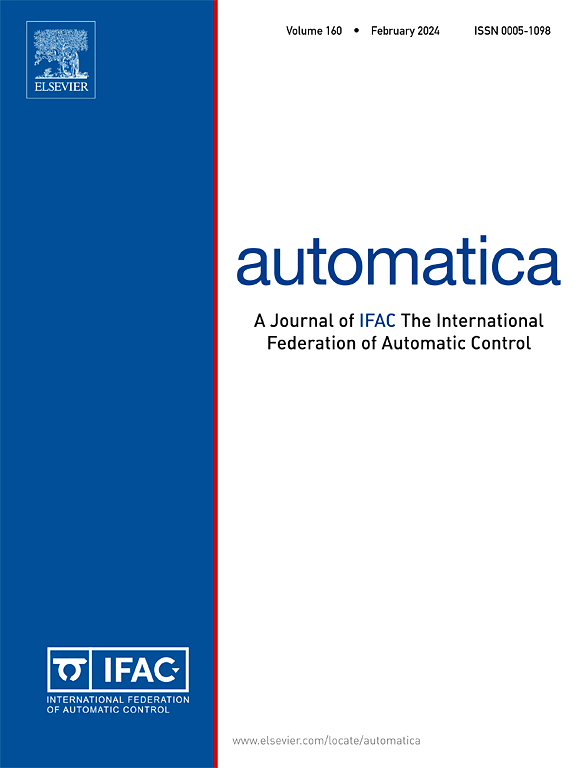On decentralized computation of the leader’s strategy in bi-level games
IF 4.8
2区 计算机科学
Q1 AUTOMATION & CONTROL SYSTEMS
引用次数: 0
Abstract
Motivated by the omnipresence of hierarchical structures in many real-world applications, this study delves into the intricate realm of bi-level games, with a specific focus on exploring local Stackelberg equilibria as a solution concept. While existing literature offers various methods tailored to specific game structures featuring one leader and multiple followers, a comprehensive framework providing formal convergence guarantees appears to be lacking. Drawing inspiration from sensitivity results for nonlinear programs and guided by the imperative to maintain scalability and preserve agent privacy, we propose a decentralized approach based on the projected gradient descent with the Armijo stepsize rule. By the virtue of the Implicit Function Theorem, we establish convergence to a local Stackelberg equilibrium for a broad class of bi-level games. Moreover, for quadratic aggregative Stackelberg games, we also introduce a decentralized warm-start procedure based on the consensus alternating direction method of multipliers addressing the initialization issues reported in our previous work. Finally, we provide empirical validation through two case studies in smart mobility, showcasing the effectiveness of our general method in handling general convex constraints, and the effectiveness of its extension in tackling initialization issues.
双层博弈中领导者策略的分散计算
由于在许多现实世界的应用中无处不在的层次结构,本研究深入研究了复杂的双层博弈领域,特别关注于探索局部Stackelberg均衡作为解决方案的概念。虽然现有文献提供了针对特定游戏结构的各种方法,但似乎缺乏提供正式收敛保证的全面框架。从非线性规划的灵敏度结果中获得灵感,在保持可扩展性和保护代理隐私的必要性的指导下,我们提出了一种基于Armijo步长规则的投影梯度下降的分散方法。利用隐函数定理,建立了一类双水平对策的收敛性,得到了局部Stackelberg均衡。此外,对于二次聚集体Stackelberg对策,我们还引入了一个基于乘法器共识交替方向方法的分散热启动过程,解决了我们之前工作中报告的初始化问题。最后,我们通过智能移动的两个案例研究提供了经验验证,展示了我们的一般方法在处理一般凸约束方面的有效性,以及其扩展在处理初始化问题方面的有效性。
本文章由计算机程序翻译,如有差异,请以英文原文为准。
求助全文
约1分钟内获得全文
求助全文
来源期刊

Automatica
工程技术-工程:电子与电气
CiteScore
10.70
自引率
7.80%
发文量
617
审稿时长
5 months
期刊介绍:
Automatica is a leading archival publication in the field of systems and control. The field encompasses today a broad set of areas and topics, and is thriving not only within itself but also in terms of its impact on other fields, such as communications, computers, biology, energy and economics. Since its inception in 1963, Automatica has kept abreast with the evolution of the field over the years, and has emerged as a leading publication driving the trends in the field.
After being founded in 1963, Automatica became a journal of the International Federation of Automatic Control (IFAC) in 1969. It features a characteristic blend of theoretical and applied papers of archival, lasting value, reporting cutting edge research results by authors across the globe. It features articles in distinct categories, including regular, brief and survey papers, technical communiqués, correspondence items, as well as reviews on published books of interest to the readership. It occasionally publishes special issues on emerging new topics or established mature topics of interest to a broad audience.
Automatica solicits original high-quality contributions in all the categories listed above, and in all areas of systems and control interpreted in a broad sense and evolving constantly. They may be submitted directly to a subject editor or to the Editor-in-Chief if not sure about the subject area. Editorial procedures in place assure careful, fair, and prompt handling of all submitted articles. Accepted papers appear in the journal in the shortest time feasible given production time constraints.
 求助内容:
求助内容: 应助结果提醒方式:
应助结果提醒方式:


